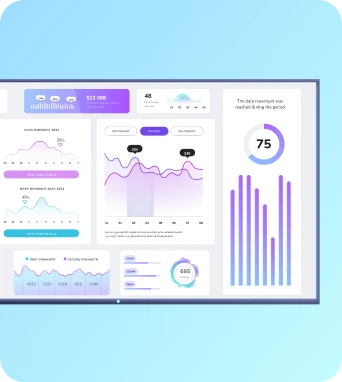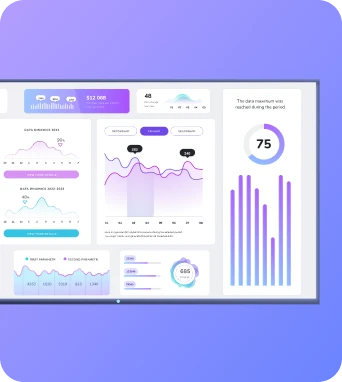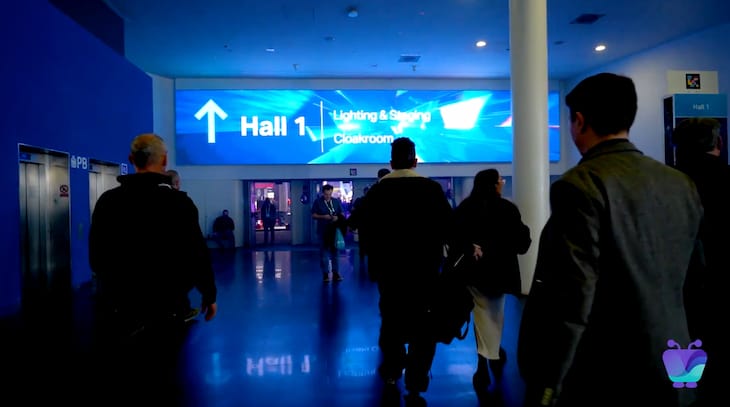Integrated Systems Europe is a pretty big deal around here. We were so jazzed about our visit in 2023 that we decided to go again to ISE 2024!
Our team rolled up to Barcelona at the end of January. Though we weren’t exhibiting at our own booth like in 2023, we still had all sorts of things to occupy our time — like giving a demonstration with Google and being an interactive partner with Sony.
Here are a few of our favorite highlights, plus our impressions about seven emerging trends in digital signage you need to know about, taken from the show floor.
Our favorite reflections from ISE 2024
So before we dive into the exciting things we learned, let’s take a look at some of the exciting things we did.
Google hosted a live demonstration of Fugo
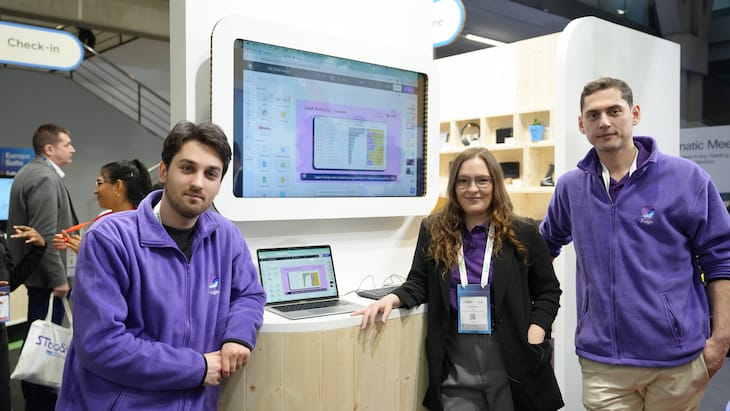
As mentioned earlier, Fugo was invited to demonstrate our solution for ChromeOS at Google’s ISE stand. We covered a lot during our time there, including:
- Why we love and prefer ChromeOS devices
- A demonstration of our integrations with the Google Workspace
- A full demonstration of our TV dashboards feature, including how to customize dashboards in our design studio
- The benefits of our partnership and what it means for our awesome end users
Want all the details? You can watch our full demonstration here:
Fugo was featured in Sony’s interactive partner showcase
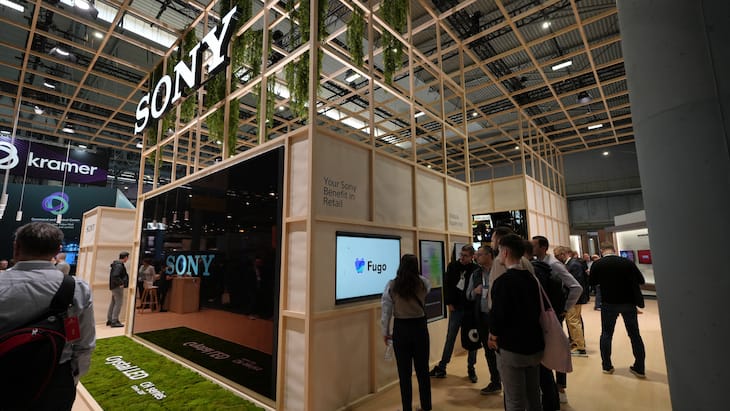
Fugo also had a week-long digital presence at Sony’s stand via their interactive partner showcase, where visitors clicked through to learn more about Fugo and watched our joint case study with Struers featured on one of the main screens at the stand.
The stand was as buzzy as always (meaning: visitors packed in like sardines) with plenty to discover about their solutions for corporate, retail, and education comms. While there weren't many new models on display this year, the BZ40L with deep black non-glare was impressive. It's one of the screens we recommend the most, and great to see a side-by-side in comparison with the BZ35L in person.
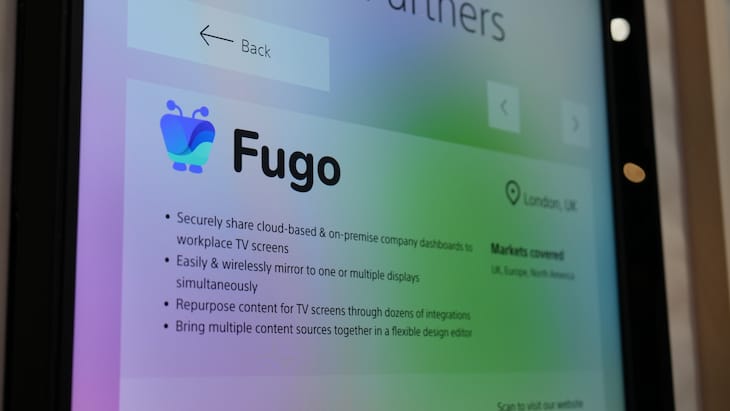
So what’s in store for the future of digital signage?
It looks like a bunch of our predictions for 2024 are already coming true.
After a week of talking to vendors, partners, and industry pundits, as well as touring the show floor, here are our main impressions about where the digital signage industry is headed in 2024.
1. The rise of the platform economy
![Samsung's VXT Platform Makes Creating and Managing Engaging Digital Signage Content a Piece of Cake – rAVe [PUBS]](https://www.ravepubs.com/wp-content/uploads/2024/02/ISE-2024-Story-Images-29.jpg)
The future of digital signage is shifting towards a more interconnected ecosystem, challenging the status quo of isolated advancements in display technologies and software functionalities.
This shift towards a 'platform economy' is evident as signage manufacturers aim to replicate the success of digital signage SaaS platforms. Nowhere was this more evident than Samsung's new VXT, unveiled amidst much debate at the show.
VXT introduces a subscription-based platform business model, complete with an App Store for digital signage partner applications, like Fugo. While Samsung envisions lots of potential benefits for ecosystem partners, plenty of vendors still have concerns about the distribution model.
Starting in 2025, Samsung plans to directly distribute VXT to end customers, potentially disrupting the value chain between manufacturer, integrator, and software provider.
Other players are also entering the arena. LG is launching its own CMS called Business Cloud, while Philips (PPD) unveiled its WAVE ProStore platform, though they’re explicitly still not getting into the CMS business.
For customers, a key question lingers: can hardware manufacturers like Samsung and LG deliver CMS offerings comparable to those of dedicated software partners like Fugo? The heat will be on for these hardware makers to truly excel in the software realm and offer solutions as robust and tailored to customer needs.
2. The proliferation of remote device management integrations
Remote device management, aka RDM, is the magic of controlling devices from anywhere. For companies with multiple locations and large digital signage programs, it’s the easiest way to manage changing content without physically visiting each screen.
As RDM becomes an expectation rather than a luxury for users, more and more hardware manufacturers are adding their own support. This includes proprietary devices AND third-party devices with manufacturer-agnostic platforms.
Can you imagine connecting all your screens and signage software without having to buy everything from the same vendor?
The future is looking bright!
3. The maturation of LED products
LED technology is getting better and more sophisticated — although you probably didn’t need me to tell you that. We saw all kinds of incredible stands with beautiful displays. Samsung even had a giant LED wall to drool over.
Here are just a few of our favorites:
- Screen Experts showed off their fireproof LED displays for airports, stadiums, and other high-risk areas. It’s currently the only screen in Europe with ‘optimized fire behavior,’ so it will be interesting to see if new competitors join the market.
- 3D-printed LED tiles from CECOCECO allow you to display images on architectural backgrounds. They’re probably too niche for most digital signage applications right now, but time will tell as companies get creative.
- AOTO Electronics debuted a 0.3mm MicroLED display, which is an extremely tiny pixel pitch. Is there high enough demand for something like this? Again, time will tell.
- German reseller Lang AG debuted a 0.9 COB wall called the LEDgend LED display (with a whopping 1,200-nit brightness level).
- Sony’s Europe-exclusive Crystal LED FLUX was a jaw-dropping 220 inches. Enough said.
- LG’s transparent OLED screens were very hard to miss. Imagine casting images/text through your bakery’s glass panels and enabling touch signage so people can select and purchase goodies.
So: can we expect to see these hit the shelves tomorrow? Probably not. But the speed of innovation in the LED space is definitely worth keeping an eye on.
4. The emergence of green signage and e-ink
More digital signage manufacturers are releasing greener products and e-ink displays. Both Phillips (PPDS) and Dynascan had e-ink displays on showcase, and our resident e-paper enthusiast and CTO had a blast pouring over the screens.
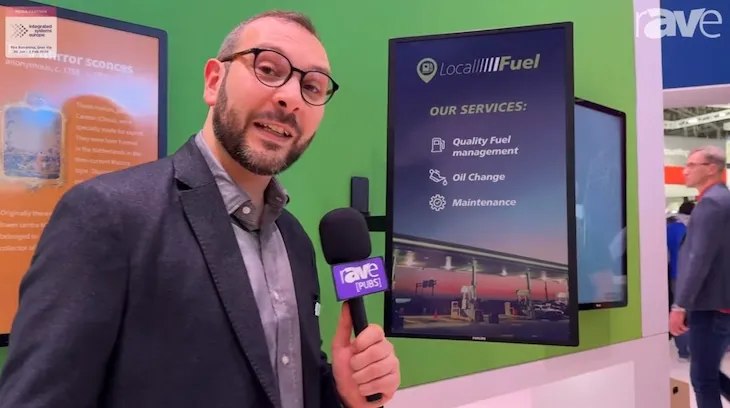
PPDS exhibited a full-color e-ink screen: the 32-inch Tableaux 5150I. They also showed off their own take on green signage with the 3650 EcoDesign. This requires just half the power consumption of other displays within the same size bracket. Since the display itself is made of post-consumer recycled plastic, it’s one of the most sustainable ones on the market.
Dynascan introduced a 42-inch e-ink display — currently the largest in the world. There was also a monochrome screen on display, which may be much more cost-effective for the foreseeable future.
Does this get you fired up? Yep, us too.
We’ve been following the rise of e-ink for a while now, and we’re feeling pretty confident that the future is green (or at least covered in tiny microcapsules).
5. IT security requirements are getting bumped up
You don’t need us to remind you there’s a big scary (cyber)world out there. Cyberattacks were up 17% in 2023, and we can only imagine what’s coming in 2024.
These days, enterprise clients require appropriate security certifications like SOC2 or ISO 27001 (the European equivalent). Thankfully, most software vendors are obtaining them. Even Fugo is set to receive our SOC2 certification this year.
We also provide mission-critical security features like:
- Storing encrypted credentials in AWS Secrets Manager (only accessible on our private servers)
- Seamless fit with existing infrastructure and best-in-class Microsoft security measures
- Frequently updated security protocols, which means you can finally rest easy at night
How’s that for peace of mind?
6. The stage isn’t quite set for concrete developments in AI
AI isn’t terribly mature in the digital signage world, but it was certainly looming over software vendors at ISE 2024.
There was much anticipation for AI to be center stage. But while it definitely was a buzzword, and many companies talked about nebulous plans to integrate solutions with ChatGPT, there wasn’t much actually demonstrated at the show. This signals that full-blown integration with AI tools is still a ways off.
There were a few interesting test cases here and there, like an AI-driven voice ordering platform and generative AI for interactive experiences. Both of these software tools have a long way to go, though — they’re very early in development.
Maybe 2025 will have more AI in store.
7. Internal comms is still king

More and more people are waking up to the fact that digital signage is a powerful weapon in the internal communications arsenal. This is especially true for frontline workers, who make up 112 million professionals in the US alone, but 65% report that they feel left in a giant technology gap as compared to knowledge workers.
Today, we see workplace digital signage continuing to move away from simple image/video presentations and toward web-generated content, business data, and engaging dashboards.
The good news is, Fugo’s features can automate a lot of this. Our app store is constantly growing to integrate screens with more of the tools you rely on for daily work. And our TV dashboards solution is one of the best tools out there for getting data to your workforce at scale…
Want to take Fugo for a test drive and get ahead of the curve?
You can sign up for a 14-day free trial and give us a spin today.


